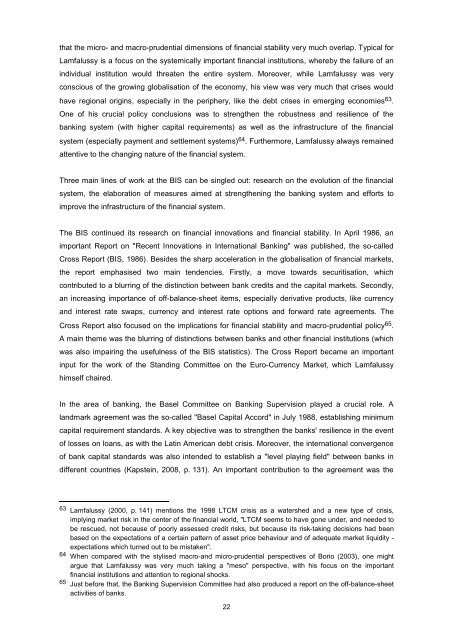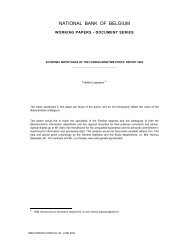Working Paper Research - Nationale Bank van België
Working Paper Research - Nationale Bank van België
Working Paper Research - Nationale Bank van België
Create successful ePaper yourself
Turn your PDF publications into a flip-book with our unique Google optimized e-Paper software.
that the micro- and macro-prudential dimensions of financial stability very much overlap. Typical forLamfalussy is a focus on the systemically important financial institutions, whereby the failure of anindividual institution would threaten the entire system. Moreover, while Lamfalussy was veryconscious of the growing globalisation of the economy, his view was very much that crises wouldhave regional origins, especially in the periphery, like the debt crises in emerging economies 63 .One of his crucial policy conclusions was to strengthen the robustness and resilience of thebanking system (with higher capital requirements) as well as the infrastructure of the financialsystem (especially payment and settlement systems) 64 . Furthermore, Lamfalussy always remainedattentive to the changing nature of the financial system.Three main lines of work at the BIS can be singled out: research on the evolution of the financialsystem, the elaboration of measures aimed at strengthening the banking system and efforts toimprove the infrastructure of the financial system.The BIS continued its research on financial innovations and financial stability. In April 1986, animportant Report on "Recent Innovations in International <strong>Bank</strong>ing" was published, the so-calledCross Report (BIS, 1986). Besides the sharp acceleration in the globalisation of financial markets,the report emphasised two main tendencies. Firstly, a move towards securitisation, whichcontributed to a blurring of the distinction between bank credits and the capital markets. Secondly,an increasing importance of off-balance-sheet items, especially derivative products, like currencyand interest rate swaps, currency and interest rate options and forward rate agreements. TheCross Report also focused on the implications for financial stability and macro-prudential policy 65 .A main theme was the blurring of distinctions between banks and other financial institutions (whichwas also impairing the usefulness of the BIS statistics). The Cross Report became an importantinput for the work of the Standing Committee on the Euro-Currency Market, which Lamfalussyhimself chaired.In the area of banking, the Basel Committee on <strong>Bank</strong>ing Supervision played a crucial role. Alandmark agreement was the so-called "Basel Capital Accord" in July 1988, establishing minimumcapital requirement standards. A key objective was to strengthen the banks' resilience in the eventof losses on loans, as with the Latin American debt crisis. Moreover, the international convergenceof bank capital standards was also intended to establish a "level playing field" between banks indifferent countries (Kapstein, 2008, p. 131). An important contribution to the agreement was the63 Lamfalussy (2000, p. 141) mentions the 1998 LTCM crisis as a watershed and a new type of crisis,implying market risk in the center of the financial world, "LTCM seems to have gone under, and needed tobe rescued, not because of poorly assessed credit risks, but because its risk-taking decisions had beenbased on the expectations of a certain pattern of asset price behaviour and of adequate market liquidity -expectations which turned out to be mistaken".64 When compared with the stylised macro-and micro-prudential perspectives of Borio (2003), one mightargue that Lamfalussy was very much taking a "meso" perspective, with his focus on the importantfinancial institutions and attention to regional shocks.65 Just before that, the <strong>Bank</strong>ing Supervision Committee had also produced a report on the off-balance-sheetactivities of banks.22
















